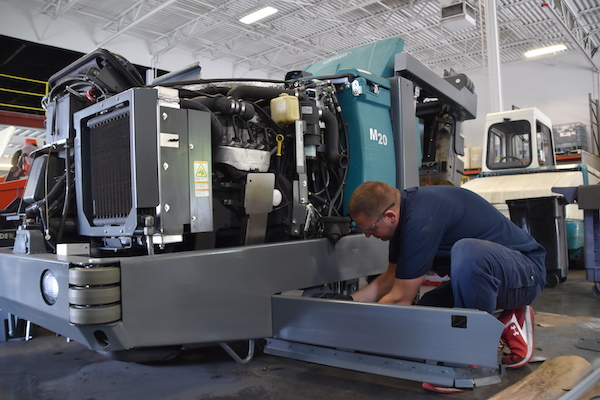
Now that the New Year is in full swing, it’s time to reexamine your processes and procedures to ensure you’re delivering the best possible floor care throughout your facility, especially when using industrial floor cleaning machines. Just like we all make personal resolutions as we enter the New Year to keep us on track, it’s helpful for those who oversee facilities maintenance to commit themselves to a new routine. Leave the old ways behind and make sure your floor care is being completed as safely and efficiently as possible.
Tips for Industrial Floor Care Success
Clean the Machine Frequently
Proper maintenance can prolong the life of floor cleaning equipment and reduce costs. Make sure to empty your floor sweeper hopper on a regular basis. For effective dust control, clean or change the floor sweeper’s filter as needed following the guidelines in your machine’s manual. When it comes to floor scrubbers like the Bulldog WD20, keeping the squeegee clean is probably the most important daily maintenance task you should do for optimal performance. Also, make a plan to clean the floor scrubber recovery tank regularly. Cleaning the tank will help keep mold and foul odors to a minimum. After cleaning you can use a product like Cool Breeze tank deodorizer. It freshens the tank and is released through the exhaust, adding a fresh smell to the job site.
Be Mindful of Storage
When parking and storing your industrial floor scrubber, lift the brush/pad and squeegee off the ground. This method helps the attachments dry properly so that the floor scrubber is prepared for the next crew member. Additionally, this will prevent the next crew member from trying to move the machine while the brush and squeegee are down, which could potentially damage your equipment.
Check Water in Battery-operated Equipment
About once a week, check water levels in battery-operated floor scrubbers and sweepers, since the electrolyte level lowers over time. The rate of this depletion is affected by the cell’s temperature and humidity levels, and older batteries may need even more frequent refilling. Even if you have a self-watering battery, you should still be mindful of water levels.
Checking the battery is especially important when your industrial floor scrubber or sweeper will be stored for a long period of time, which is typical for seasonal businesses. Batteries will slowly discharge even if disconnected or not used, and if they completely discharge then they will have to be replaced. While in storage, set a schedule to check and charge your battery-operated floor cleaning machine every two or three weeks.
Inspect Brushes
Debris, dust and other items can accumulate around brushes, so thoroughly inspect before each use to ensure they’re free from any foreign objects that can damage the machine or floor. Make sure there is nothing wrapped around the brush. Shrink wrap or banding wrapped around brushes will eventually ruin the brush motors or bearings.
Rotate Brushes
The scrubbing brushes on industrial floor scrubbers and sweepers should be rotated at least every two weeks so that they’re all getting equal wear and tear.
Flip the Squeegee Blades
Most floor scrubber squeegee blades have 4 usable edges. When the sharp leading edge of the squeegee is worn, flip the blade end for end. When the bottom 2 edges are worn, simply turn the squeegee over and use the top 2 edges.
Watch Your Turns
Drive your industrial floor scrubber or sweeper like you do your lawn mower: Only make left-hand turns for a clean and complete job. Communicate this guideline to all members of the crew so everyone follows a standard plan for cleaning. Also, check periodically to make sure that signaling devices like lights and horns are in good working order to keep all staff members safe around the floor cleaning machines.
Set a Cleaning Schedule
Sticking to a schedule is a common personal New Year’s resolution, and keeping your crew on an agreed-upon schedule for floor care can also be highly effective on a number of fronts. Setting and following a cleaning schedule communicates strong leadership, as well as the importance of floor care, a recognition that can trickle down through the ranks. It also promotes sustainability, as cleaning schedules have been proven to reduce water and electricity consumption. Safety is a concern for many facilities managers and maintenance crews, and keeping all members on a set cleaning schedule helps reduce potentially costly floor hazards like spills, dust and debris.
Check Supply Levels
Keep on top of the amount of wear items in stock, like squeegees, brushes, and hoses, along with detergents and chemicals. Running out of supply in the middle of a cleaning job can reduce productivity and pose safety risks. Build a good relationship with a reliable floor chemicals and parts supplier like Factory Cleaning Equipment who will ensure that you always have the supplies you need.

